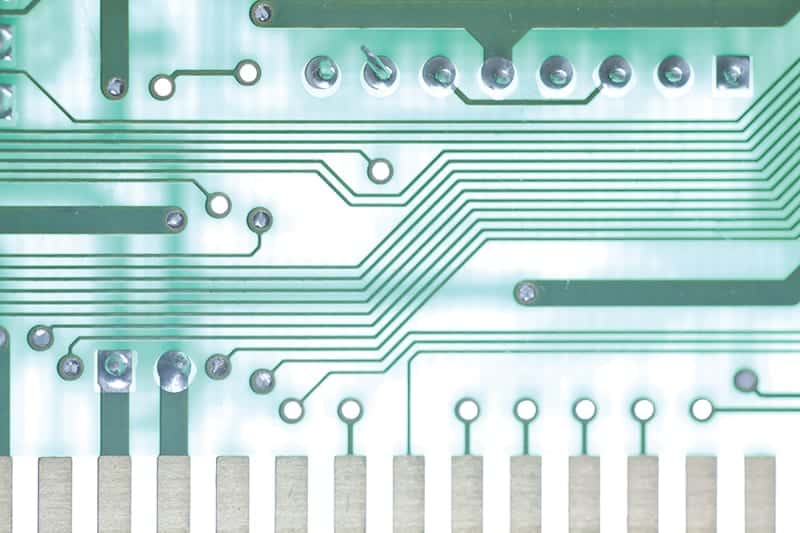OCTOBER 2016 | Vol. 13, No. 10
Conductive paints and coatings are widely used in the production of electronic products and in a number of applications in other industries. The biggest applications are the creation of electrodes and contacts and for antistatic and electromagnetic interference (EMI)/radio frequency interference (RFI) shielding. They can be applied to both flexible and rigid substrates using many different methods, including screen, flexographic, and rotogravure printing methods and come in heat and UV-curable formulations. Conductive inks and coatings are commonly based on metals (e.g., silver, copper), conductive metal oxides (e.g., indium tin oxide), conductive polymers (e.g., polyaniline and derivatives), and nanomaterials (e.g., nanosilver).
In recent years, designers have taken conductive paints out of the industrial setting and into the do-it-yourself market. Jars and pens of electrically conductive paint that can be applied to textiles, paper, plastics, and other surfaces are now available in stores. Many people are taking advantage of the opportunity to use the material to create clothing, posters, and other objects that can emit light and make music.
Bare Conductive, based in London, UK, offers its conductive Bare Paint and a range of kits that allow customers to create functional and interactive projects. The company was founded by Isabel Lizardi, Matt Johnson, Bibi Nelson, and Becky Pilditch—students of London’s Royal College of Art (RCA)—who initially wanted to apply electronics to the skin. They started using copper powder and glue. The paint they offer today is different—nontoxic, water-based, and based on carbon—and can be applied to paper, wood, cement, textiles, and other substrates. It becomes conductive once it dries. The idea of an electrically conductive body paint was abandoned due to the difficulty in meeting the complex regulatory requirements for cosmetic products. The group received a £100,000 grant from the Technology Strategy Board and was selling its paint and a pen for drawing circuits by late 2011.
Today, in addition to its Electric Paint, Bare Conductive sells a Touch Board that can transform Electric Paint sensor data into any output, such as sound, light, movement, or data in the cloud. A range of kits is available to help customers of all experience levels implement their design ideas. Educational products are also offered by the company that teach concepts such as resistance, circuitry, polarity, and voltage in fun and creative ways. For instance, one kit involves the drawing of greeting cards that light up.
The paint has been used for very simple applications like fixing broken electronics to wildly creative projects. Denver-based visual artist Thomas Evans (AKA Detour), in collaboration with musicians/performers Felix Fast Forward and duo Jiggy Thompson, in 2015 created “Red Bull House of Art Synesthesia.” This included custom pieces of art to be played in front of an audience and explored the boundaries between art, music, and performance. Evans also uses the Electric Paint and Touch Board to integrate capacitive sensors into his oil-based portraits of musicians to make his art interactive and bring sound onto canvas. When the Touch Board is set in MIDI (Musical Instrument Digital Interface) mode and hooked up to a computer, it functions as an instrument, allowing for performances.
In another example from 2015, Studio PSK, a communication design practice based in Peckham, South East London, that works with brands, companies, and galleries to tell stories through interactive objects, spaces, installations, and graphics, created the Polyphonic Playground. This uses capacitive sensing to manipulate sound and trigger lighting effects as visitors interact with the structure. Viewers can touch the sensors with their hand, climb the frame, or swing on the canvas seats. Design studio EJ Tech, an experimental art and tech lab based in Budapest, Hungary, created Liquid MIDI, soft and flexible controllers by using Bare Conductive’s Electric Paint with a silk screen to print intricate graphic sensors. Designer and musician Vahakn Matossian from Human Instruments also created in 2015 the first fully customizable expressive digital instrument using the Touch Board. People can create music using both touch and breath sensors.
Separately, textile designer Selina Reiterer and architect Constantinos Miltiadisin created musical t-shirts for children using a washable electric paint designed for use on textiles. Their “JOHN PAUL GEORGE & ME” project includes three shirts with different designs that represent different instruments (guitar, bass, and drums) that make sounds like the corresponding instruments when touched. When “played” together they form a “rock band.” The patterns were silk-screen printed on plain T-shirts using the nontoxic conductive paint. The painted shapes are connected using conductive thread to a microcontroller that sits in a removable pocket in the back of each shirt. The generated signals are picked up via Bluetooth LE (Low Energy) by a multi-platform mobile application that plays back the sounds in real time. In addition to serving as an interactive musical game, the shirts also encourage children to collaborate to create and perform music.

